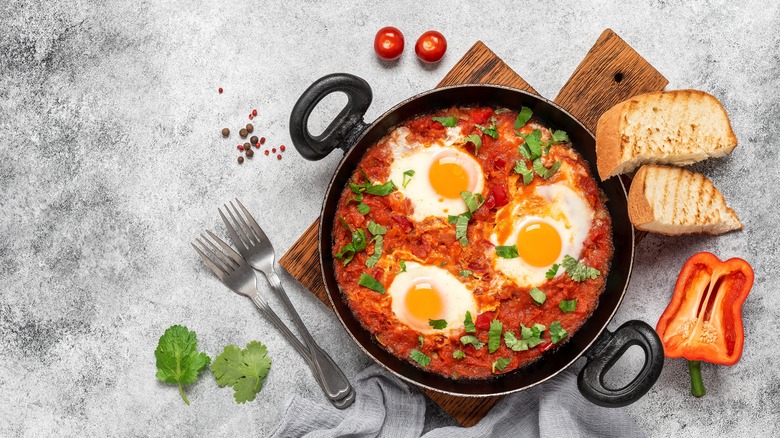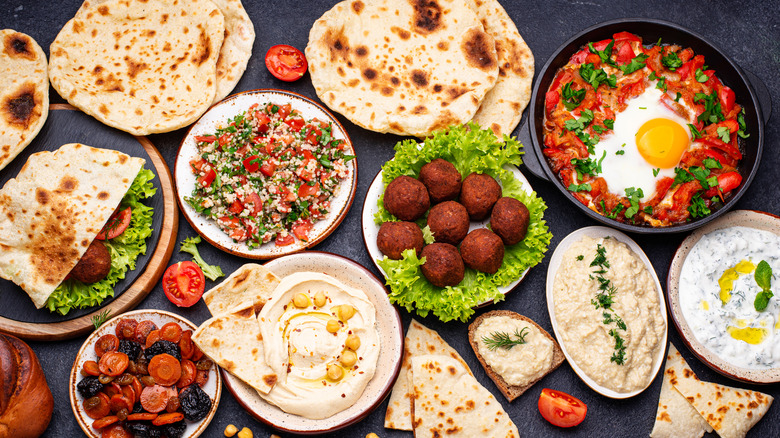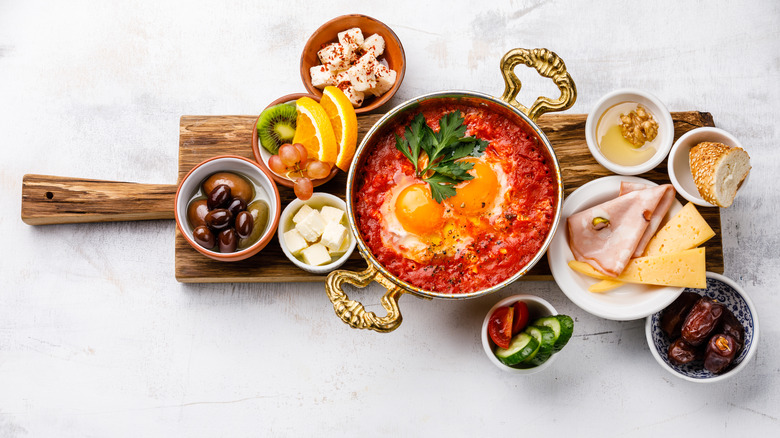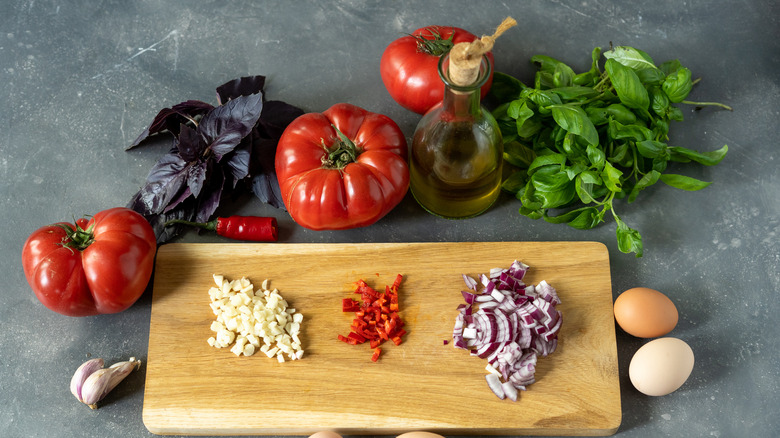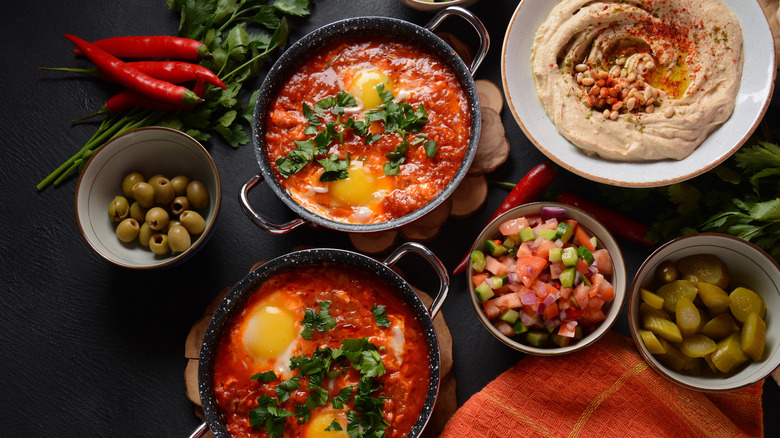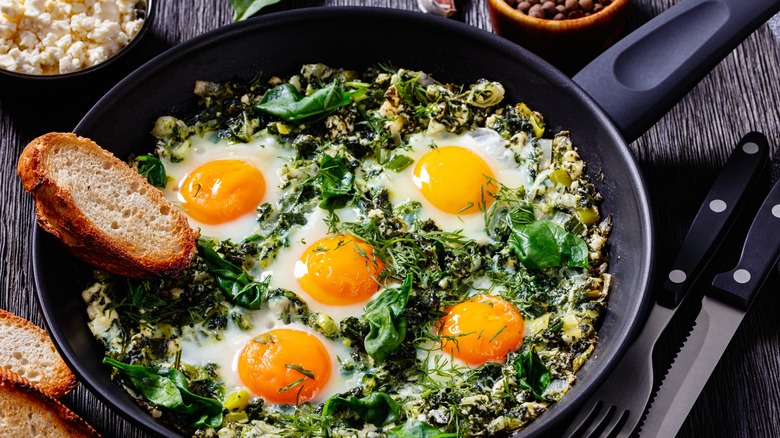All Your Burning Questions About Shakshuka, Answered
When you think of making the perfect brunch, it often includes something along the lines of a plate of eggs benedict, a stack of sweet pancakes, or any host of breakfast foods that can be enjoyed really at any hour of the day. While Americans have certainly embraced the concept of brunch foods, we aren't the only ones who have popularized the idea of eating our favorite foods at any given time of the day.
Shakshuka is the name of a famous brunch dish, typically associated with Israeli and Mediterranean food cultures. While it is largely served as a breakfast and brunch food today, it is traditionally thought to be a dish that can be prepared for any meal at any time of day. If you've never heard of or tried shakshuka, firstly, you need to find a new brunch spot. Secondly, we're here with all of the need-to-know facts about this popular food, from its origins to how you can make it on your own. Below you'll find answers to every question you may have about this delicious dish, and hopefully some inspiration for your next recipe as a bonus.
What is shakshuka?
For those of you who aren't familiar, we're here to break down this delicious food. Shakshuka is a dish that can traditionally be eaten for breakfast, lunch, or dinner which is the first thing that makes it so great. The name shakshuka translates to "shaken up," which perfectly describes the way this dish is prepared and served.
The two main components of this savory dish are the tomato sauce base and the eggs, which can be prepared in a variety of ways depending on preference. Traditionally, the eggs are softly poached in a chunky, fragrant tomato sauce. This tasty dish is typically served in the iron pan that it is cooked in, often with a side of bread that is used to dip in the tomato sauce and runny eggs. While that is the most simple way of preparing shakshuka, there are a variety of ways to add your own flare.
Where does it originate from?
While many would widely consider shakshuka to be an Israeli meal, the origins of this delicious dish are thought to be in North Africa — some believe it to have originated in Tunisia, while others say Yemen. Despite ongoing debates over shakshuka's true origin, there is no denying its popularity as it is most commonly associated as a breakfast dish in the Middle East in addition to North Africa.
Shakshuka reached Israel in the 1960s when Jewish immigrants brought the inspiration for the dish over from North Africa. Considering the simple list of ingredients required, with just eggs, vegetables, and bread making up the entire meal, shakshuka was an affordable food that turned into quite the sensation. The dish first appeared on Israeli restaurant menus in the 1990s and has taken off since then. Nowadays, shakshuka is a dish that has been popularized everywhere and can be found at many breakfast or brunch spots across the world.
How and when shakshuka is served
The best part about shakshuka is that there are no "shoulds" with this dish. While it is a perfect brunch food because of its flexibility, that aspect of shakshuka is also what makes it for any time of day. Traditionally, shakshuka is served for breakfast, lunch, and dinner and can be adjusted accordingly.
There's truly no wrong way to serve shakshuka, except for the common belief that it is best enjoyed when eaten out of the pan it's cooked in along with a side of your bread of choice. Otherwise, there are a number of ways to serve shakshuka to fit the meal or occasion. For example, shakshuka can be served with a side of plain yogurt for breakfast to give the meal an extra boost and some variety. For lunch, any assortment of Mediterranean sides might work with this dish from a side salad to other mezze platter sides.
Ingredients needed for shakshuka
As mentioned, the main ingredients that you'll need for this dish are eggs and those to make a tomato sauce. Depending on the season, you can use fresh tomatoes or canned for the base of the sauce. Otherwise, most classic shakshuka recipes use bell peppers and onions in addition to the tomatoes to make the sauce. You'll want to have plenty of seasonings on hand, including paprika, cumin, and cayenne pepper for a bit of spice.
The rest of the ingredients are where your personal preferences come into play. If you like things a bit more on the spicy side, some recipes call for harissa sauce for that chili flavor. Some may also opt to add meat to their dish for extra protein and a boost of flavor, common additions being cuts of lamb or beef — either ground or cut into small pieces. The last main ingredient is your bread of choice to be served on the side. Most will opt for simple, sliced bread, but you can also use trust pita bread as your vessel. To top it all off, many use fresh herbs like parsley and mint to add some finishing touches to the dish.
How to make shakshuka
If we haven't already convinced you that shakshuka should be your next favorite brunch dish, it's also super easy to make at home. In terms of kitchenware, all you'll need for this tasty dish is an iron skillet that can be used to cook and serve the shakshuka. Once you have your pan, recipes advise to start by roasting the vegetables first and foremost. The garlic and onion are going to flavor the tomato sauce, so making sure those are slightly caramelized is an important first step.
Making the sauce is pretty much the hardest part, as what follows is just a matter of timing. You'll add your desired number of eggs by simply cracking them into the prepared tomato sauce, and cover the pan for just enough time to allow the eggs to set. Depending on how much you like your eggs to be cooked, the amount of time they're covered can vary. If you're adding meat to your shakshuka, the meat of choice gets cooked with the rest of the vegetables before finishing off the sauce.
Lastly, the fun part — all the toppings. Depending on how adventurous you want to get, you can add any number of toppings as garnish once the eggs are finished cooking. To keep it simple, mint and parsley will do. Other options include adding feta cheese or sliced avocado.
The best way to enjoy shakshuka
While shakshuka can certainly be served alone and speak for itself, one of the best ways to enjoy this traditional dish is to make it the centerfold of a feast that includes other small plates. Whether it's for breakfast or dinner, there is a wide array of foods that can accompany a shakshuka and complete your table for the perfect family meal.
As far as dips go, the obvious choice is always a delicious hummus to pair with the pita bread that can also be served with the shakshuka. As a side note, you can also make a pita sandwich with the shakshuka by carefully placing it into a slice of soft bread. Another tasty, refreshing side could be an Israeli salad, a simple combination of tomatoes, cucumbers, and other fresh ingredients to balance out any meal. Other sides such as roasted vegetables work as well — the sky is truly the limit.
Varieties of shakshuka
While the traditional version of this dish certainly is a must-try, the beauty of shakshuka is that it can be made and adjusted to any preference. If you want to take things a step further than a couple of extra add-ons, there are a few different takes on shakshuka that you can try. Green shakshuka is another take on the original recipe, using tomatillos to give the dish a green color and spicy flavor.
There are endless other ways to give shakshuka a twist, including incorporating flavors from other cuisines. This Korean shakshuka recipe is a perfect example, keeping the general idea of the dish the same while incorporating different ingredients. The tomato base takes on a gochujang flavor, traditionally used in many Korean dishes. Indian-style shakshuka is another great option, using a masala sauce as the base to change the flavor profile. No matter which version you try, this dish will not disappoint.
